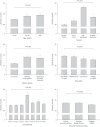Vitamin D and diabetes in Koreans: analyses based on the Fourth Korea National Health and Nutrition Examination Survey (KNHANES), 2008-2009
- PMID: 22247968
- PMCID: PMC3504347
- DOI: 10.1111/j.1464-5491.2012.03575.x
Vitamin D and diabetes in Koreans: analyses based on the Fourth Korea National Health and Nutrition Examination Survey (KNHANES), 2008-2009
Abstract
Aims: A causal relationship between vitamin D deficiency and the incidence of diabetes mellitus has been suggested, but little research has been conducted on the Korean population.
Methods: We analysed the glucose tolerance status and serum 25-hydroxyvitamin D concentrations in 12263 subjects >19 years old who were registered for the Korea National Health and Nutrition Examination Survey, 2008-2009.
Results: Various demographic variables such as gender, age, season, resident area, physical activity, smoking, alcohol, marital status, education and occupation were associated with serum 25-hydroxyvitamin D concentrations. After adjusting for these variables as confounders, 25-hydroxyvitamin D concentrations in subjects with diabetes were significantly lower than those in subjects with normal glucose tolerance and those with impaired fasting glucose (P=0.005). Compared with the ≥ 75 nmol/l subgroup of serum 25-hydroxyvitamin D concentration, the odds ratios and 95% confidence intervals for diabetes mellitus were 1.206 (95%CI 0.948-1.534) in the 50- to 74-nmol/l subgroup, 1.339 (1.051-1.707) in the 25-to 49-nmol/l subgroup and 1.759 (1.267-2.443) in the <25-nmol/l subgroup. Compared with the serum ≥ 75-nmol/l 25-hydroxyvitamin D subgroup, serum insulin and homeostasis model assessment 2%B, a marker of insulin secretory capacity, were significantly higher, and homeostasis model assessment 2%S, a marker of insulin sensitivity, was significantly lower in the <25- and 25- to 49-nmol/l serum 25-hydroxyvitamin D subgroups than those in the other subgroups (P<0.001).
Conclusions: The findings suggest that vitamin D deficiency, possibly involving altered insulin sensitivity, is associated with an increased risk for diabetes mellitus in the Korean population.
© 2012 The Authors. Diabetic Medicine © 2012 Diabetes UK.
Figures

References
-
- Boucher BJ. Vitamin D insufficiency and diabetes risks. Curr Drug Targets. 2011;12:61–87. - PubMed
-
- Rosen CJ. Clinical practice. Vitamin D insufficiency. N Engl J Med. 2011;364:248–254. - PubMed
-
- EURODIAB Study Group. Vitamin D supplement in early childhood and risk for Type I (insulin-dependent) diabetes mellitus. The EURODIAB Substudy 2 Study Group. Diabetologia. 1999;42:51–54. - PubMed
-
- Hypponen E, Laara E, Reunanen A, Jarvelin MR, Virtanen SM. Intake of vitamin D and risk of type 1 diabetes: a birth-cohort study. Lancet. 2001;358:1500–1503. - PubMed
MeSH terms
Substances
LinkOut - more resources
Full Text Sources
Medical

